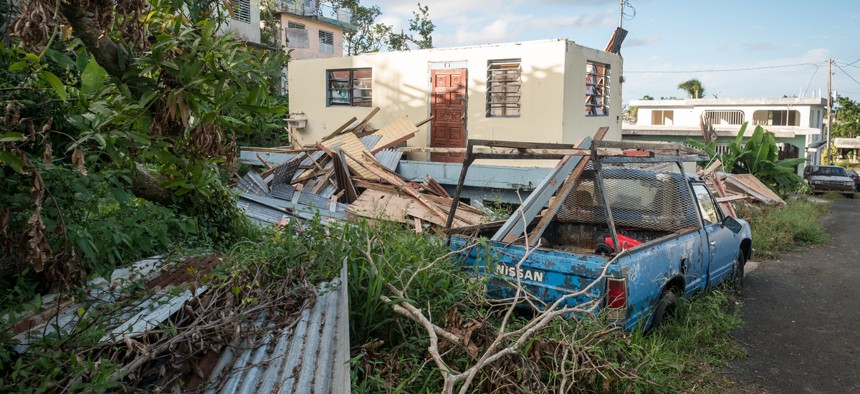What a Wisconsin Mayor Learned From a Disaster Recovery Trip to Puerto Rico

Damage from Hurricane Maria in Puerto Rico. Shutterstock
“While the tens of millions of dollars are not there to do anything of any great size, there is the potential to start small and build an economy around local residents,” Madison Mayor Paul Soglin told Route Fifty.
A Wisconsin mayor flew to Puerto Rico last weekend to help local officials rebuild in the wake of Hurricane Maria, part of a nationwide initiative pairing island leaders with their counterparts from the mainland who have experience with disaster recovery.
The trip was less about helping the island physically rebuild and more about addressing problems that existed before the hurricane, according to Madison Mayor Paul Soglin.
“You’d think that with all the problems involving infrastructure, electricity, things of that sort, that’s what the focus would be, but for a couple of reasons, that’s not the focus, at least on our end,” Soglin told Route Fifty in an interview. “First, the cost of shipping equipment and goods is prohibitive. Second, the major problems that we incurred with our municipality predate Hurricane Maria, and if they’d been addressed over the past 100 years, the significance of Maria would be reduced.”
The trip was organized as part of the Mayors Exchange initiative, a national project launched in February by the New York-based Open Society Foundations. The program allows mainland mayors to “share ideas, expertise and lessons” from their own recovery efforts in hopes of creating an ongoing relationship for mutual learning, according to the foundations.
Soglin, a Midwestern mayor, has never grappled with a hurricane, but he’s dealt with other natural disasters, ranging from blizzards to wind storms. He also has significant experience in economic development, which he sees as a key factor to Puerto Rico’s recovery.
“We have ice storms, we have tornadoes, we occasionally have flooding,” he said. “But we’ve also got the long-term experience of developing a robust local economy.”
Each of the exchange program’s 40 mainland mayors is matched with an island municipality, Soglin said. He and his deputy mayor traveled to the municipality of Toa Baja, located on the northern lip of the island, about a 15-minute drive from San Juan. The duo met with local leaders, who gave them a tour of the area and the outstanding damage from the storm.
“The wealthy areas seem to be functioning pretty well and the poorer neighborhoods were, as they say, the land of blue roofs, which refers to the blue tarps that are covering the roofs of buildings,” Soglin said. “There’s a lot of contrast between the wealthy areas and the lower-income places.”
Much of the storm damage in Toa Baja was the result of river flooding, a problem Soglin said had been noted by assessors for decades but had never been properly addressed.
“This river has always flooded, and the Army Corps of Engineers has frequently worked on solutions to the problems but they haven’t been implemented,” he said. “As to why, that’s something that the government of the United States of America, which owns this commonwealth, this territory, needs to answer.”
The municipality also has strong natural resources, Soglin said. It’s adjacent to San Juan’s harbor and has beach access, as well as a strong food-cart culture with dozens of tasty choices. But the industry is disorganized and could benefit from some input, Soglin said.
“Just imagine, you’re driving along a highway by the beach and there’s a guy with a pick-up truck who’s brought along a half-dozen plastic chairs and a couple of tables—so you’re literally sitting on the edge of the highway having this great food,” he said. “With just a little design work, let’s bring five of these guys together, let’s get them off the shoulder of the highway, and give the diners seats that are closer to the water than they are to passing automobiles. That’s not an enormous capital investment.”
Redirecting the local food industry toward the beaches is an easy way to enhance the local economy, Soglin said.
“While the tens of millions of dollars are not there to do anything of any great size, there is the potential to start small and build an economy around local residents,” he said. “You build off their existing assets.”
In the coming weeks, Toa Baja’s leaders will visit Madison to continue discussions about those proposals. Any funding for initiatives would have to be raised locally, Soglin said, but he’s hopeful that the conversations will raise awareness of the ongoing issues on the island.
“I hope it highlights and puts a spotlight on these challenges. If this one municipality has this flooding river for a century or two, how many other regularly flooding rivers are there? If this one municipality has an abandoned city hall because the roof got blown off and the water damage has resulted in all this mold, how many other municipal buildings are like that?” he said.
“I think what’s really impactful is understanding that the devastation of the hurricane and the follow-up did not have to be so devastating if we’d been taking care of things for the last hundred years.”
Kate Elizabeth Queram is a Staff Correspondent for Government Executive’s Route Fifty and is based in Washington, D.C.
NEXT STORY: Oregon's pot data needs better security





